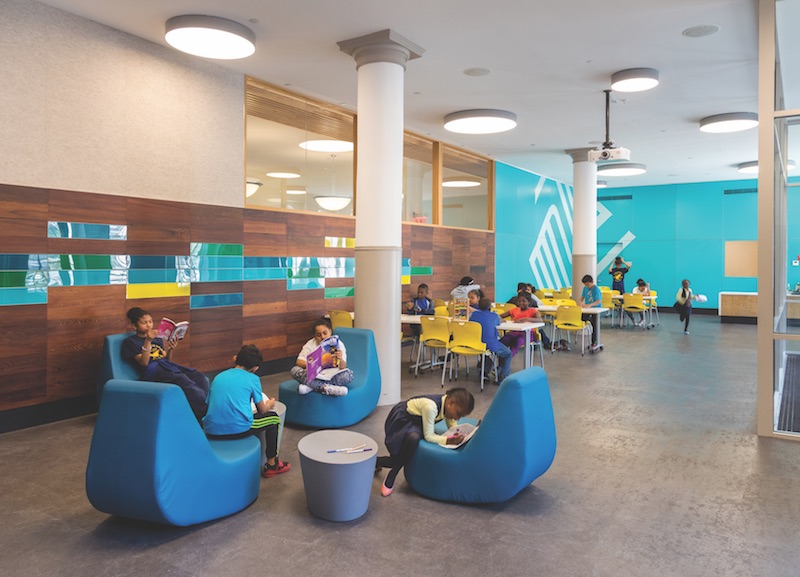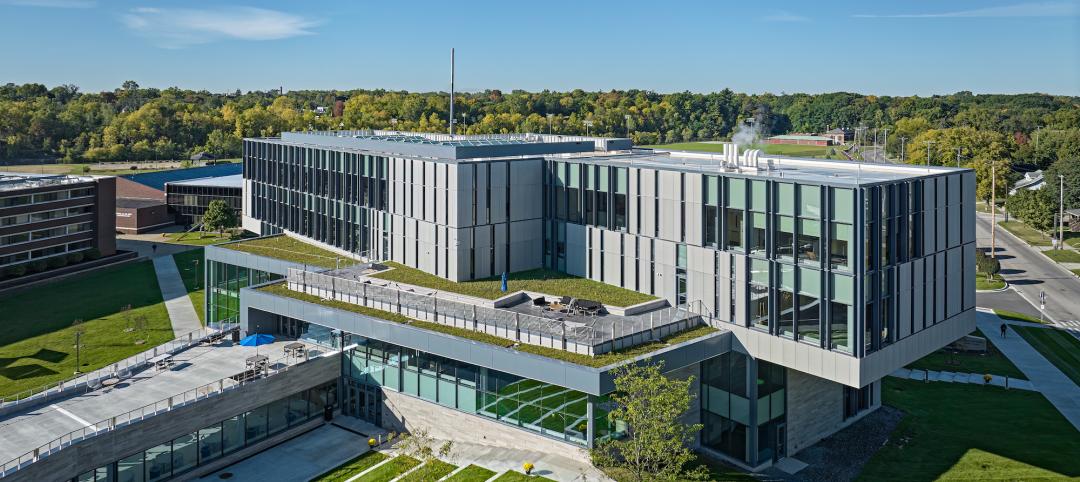The adaptive reuse of PS 186 in West Harlem shows what can be done when imagination and determination come together.
Through the combined efforts of the Boys & Girls Club of Harlem and its development partners, an abandoned public school has been turned into an anchor institution for the Hamilton Heights neighborhood. The adaptive reuse of the 114-year-old school provides two sorely needed services: an 11,300-sf clubhouse with an after-school program and teen center, and 79 units of affordable housing in a neighborhood that is feeling the negative effects of gentrification.
PS 186 was designed by architect Charles B. J. Snyder, Superintendent of School Buildings for the NYC Board of Education from 1891 to 1923. The five-story buff-and-red-brick structure, designed in the Italian Renaissance Revival style, followed Snyder’s signature H-shaped floor plan, which formed open courtyards that brought daylight into the classrooms.
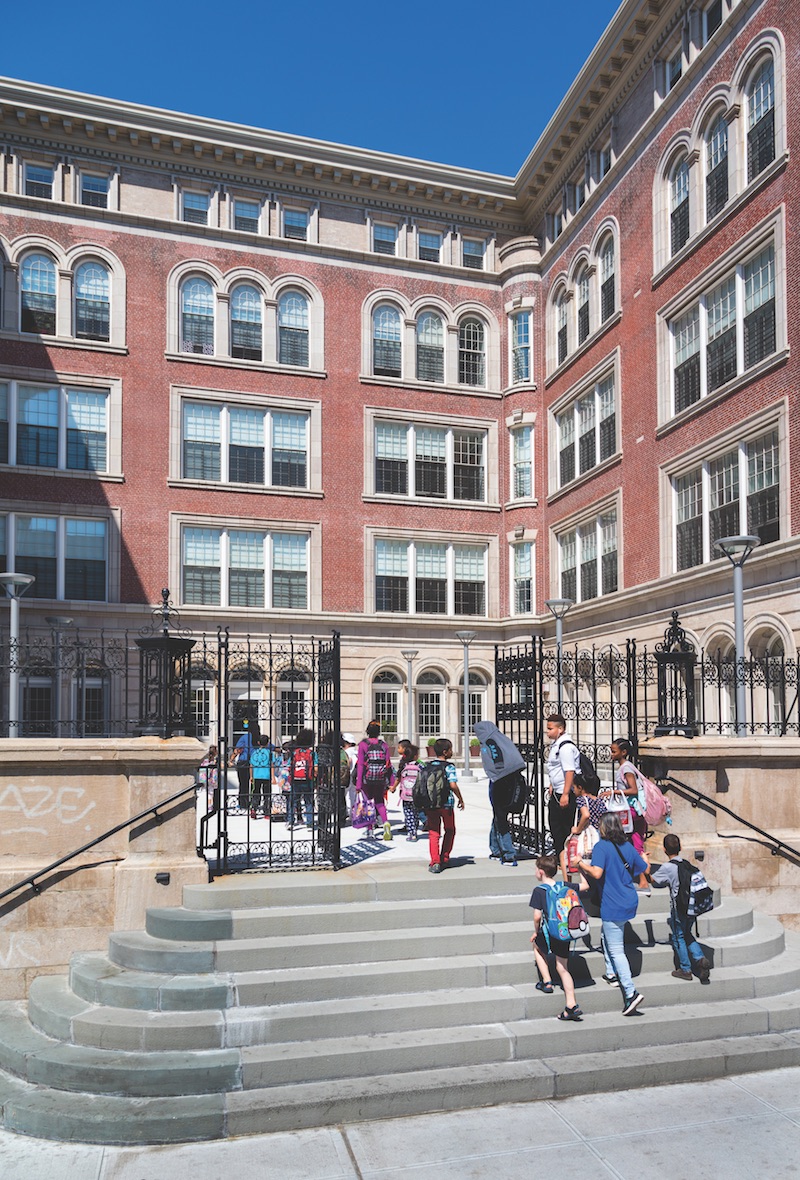 Children enter the Boys & Girls Club of Harlem at the upper courtyard on 145th Street. The decorative metal railings and gates were carefully reconstructed. Another entrance provides an ADA-compliant walkway to the residential quarters.
Children enter the Boys & Girls Club of Harlem at the upper courtyard on 145th Street. The decorative metal railings and gates were carefully reconstructed. Another entrance provides an ADA-compliant walkway to the residential quarters.
Completed in 1903, the school was immediately filled with the children of immigrant families.
PS 186 continued to serve the neighborhood around 145th Street and Amsterdam Avenue for another seven decades, but in 1975 the city declared it unsafe for occupancy, closed it, and transferred the site to the New York County Local Development Corporation. In 1986, the Boys & Girls Club of Harlem (BGCH) bought the property for $215,000.
There it sat for more than two decades. Weeds, even whole trees, clogged the classrooms. Wood floors turned spongy from the damp conditions. Hundreds of pigeon carcasses littered the upper floors. Homeless people squatted amid the ruins. Members of Community Board 9 and the local homeowners association called for the BGCH to take action. Some in the community demanded that the building be razed.
In 2009, the club, in partnership with Alembic Development, proposed a $79 million plan to demolish the school and build a new 200,000-sf home for the group, plus affordable housing, and community and retail space.
Word that PS 186 might be demolished brought out the preservationists, whose letter-writing campaign gained the support of the New York Landmarks Conservancy. But when the community board turned down a bid to have the school declared a landmark, the BGCH claimed that renovating the building without the attendant historic preservation tax breaks was not feasible.
Everything started to change in 2012, as rumors of a plan to reuse PS 186 began to buzz through the streets of West Harlem. In late 2013, Monadnock Construction bought the building from the Boys & Girls Club. Shortly thereafter, Dattner Architects was hired to seek a rezoning for a mixed-use redevelopment with affordable housing and a flagship location for the club. Preservation, once thought impossible, was now the seen as the enlightened path.
What made the deal financially feasible was a conditional approval from the National Park Service stating that PS 186 represented a historically significant example of early 20th-century school architecture. This made it eligible for listing on the National Register of Historic Places and opened the door to what would become about $20 million in historic preservation tax credits.
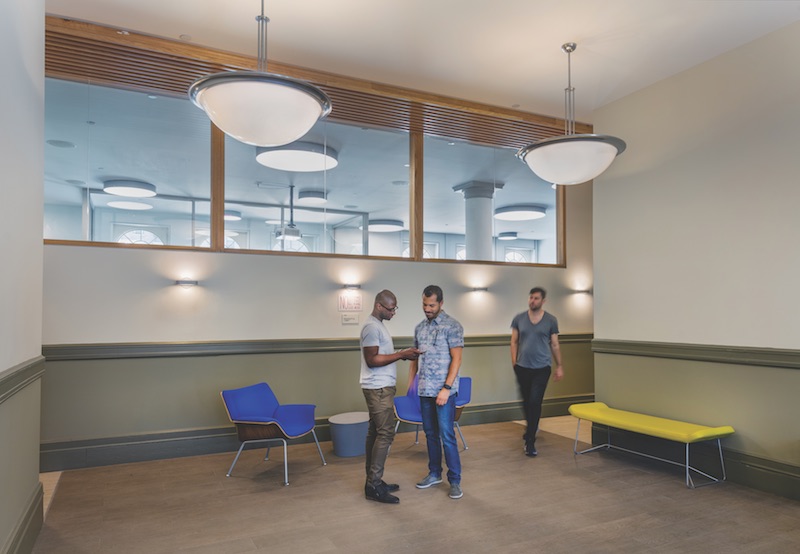 The development provides 79 affordable housing units on its four upper floors: 19 studios, 39 one-bedrooms, 12 two-bedrooms, and nine lofts. Monthly rents range from $508 for a subsidized studio to $2,738 for a market-rate two-bedroom. The 100,520-sf project is participating in the Enterprise Green Communities sustainability program.
The development provides 79 affordable housing units on its four upper floors: 19 studios, 39 one-bedrooms, 12 two-bedrooms, and nine lofts. Monthly rents range from $508 for a subsidized studio to $2,738 for a market-rate two-bedroom. The 100,520-sf project is participating in the Enterprise Green Communities sustainability program.
To comply with the NPS ruling, the reconstruction had to adhere to the Secretary of the Interior’s Standards for Rehabilitation. This meant that the project team had to maintain Snyder’s H-shaped floor plan. Numerous character-defining interior features—ornamental staircases, high ceilings, and a decorative stage known as the principal’s platform—were also preserved.
Key elements of the Italian Renaissance exterior were restored. Based on historic photographs of the original cornice, now damaged beyond repair, the design team worked with a manufacturer to create a support system for a new glass-reinforced cornice. A niche overlooking the historic entry to the school that holds a statue of Minerva, goddess of wisdom and knowledge, also was rejuvenated.
The north and south courtyards were reclaimed. From specimens of existing material, the team reconstructed the decorative iron railings and gates. Stone stairs that had been replaced with concrete block were brought back to their virginal state. An ADA-compliant entry walkway from the street to the residence entry was installed. Two new exit doors were punched out to provide safe egress from the apartment floors (two to five).
Sound attenuation in the residential floors was also addressed. Window units and exterior glass doors were recreated from historic photographs and extant drawings of the school.
Although it took 30 years to complete, the project was applauded by the Reconstruction Awards jury as a shining example of what can be done to bestow new life on the thousands of vacant public schools that face ruin in America’s older cities. Others apparently agree. The project has also won the New York Landmarks Conservancy Lucy G. Moss Award and the Society of American Registered Architects New York Design Award.
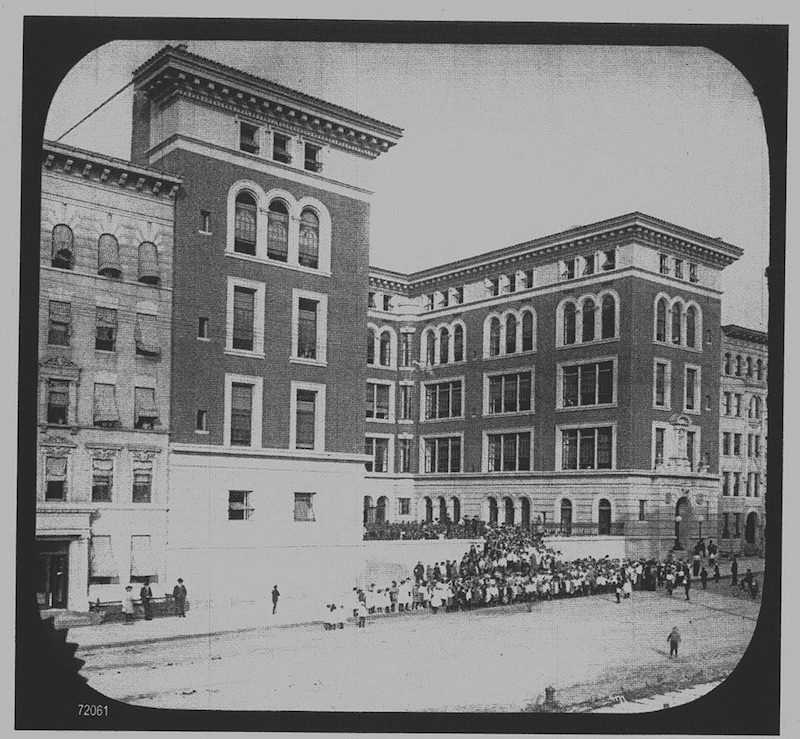 PS 186 opened in 1903 in response to the population explosion in the Hamilton Heights section of Harlem. The school offered adult night classes and became a neighborhood institution but closed in 1975. With its recent renovation, it is back as a community hub.
PS 186 opened in 1903 in response to the population explosion in the Hamilton Heights section of Harlem. The school offered adult night classes and became a neighborhood institution but closed in 1975. With its recent renovation, it is back as a community hub.
Project Sumamry
Platinum Award Winner
Building Team | Dattner Architects (submitting firm, architect, interiors) Boys & Girls Club of Harlem, Alembic Community Development, and Monadnock Development (owners) DeNardis Engineering (SE) Abraham Joselow PC (MEP) Michael A. Tomlan, FAPTI (historic preservation consultant) Construction Specifications, Inc. (specifications) Lumen Architecture (lighting) AKRF (acoustics) JM Zoning (expediting) SWA (sustainability consultant) Jim Harwood Architects (ornamental masonry consultant) Monadnock Construction (GC).
Details | 111,820 sf Total cost $45.4 million. Construction time: March 2012 to October 2016. Delivery method: Design-bid-build.
See all of the 2017 Reconstruction Award winners here
Related Stories
Education Facilities | Mar 15, 2023
DLR Group’s Campus Planning Studio defines new leadership
Linsey Graff named Campus Planning Leader. Krisan Osterby transitions to Senior Planner.
Student Housing | Mar 13, 2023
University of Oklahoma, Missouri S&T add storm-safe spaces in student housing buildings for tornado protection
More universities are incorporating reinforced rooms in student housing designs to provide an extra layer of protection for students. Storm shelters have been included in recent KWK Architects-designed university projects in the Great Plains where there is a high incidence of tornadoes. Projects include Headington and Dunham Residential Colleges at the University of Oklahoma and the University Commons residential complex at Missouri S&T.
University Buildings | Feb 23, 2023
Johns Hopkins shares design for new medical campus building named in honor of Henrietta Lacks
In November, Johns Hopkins University and Johns Hopkins Medicine shared the initial design plans for a campus building project named in honor of Henrietta Lacks, the Baltimore County woman whose cells have advanced medicine around the world. Diagnosed with cervical cancer, Lacks, an African-American mother of five, sought treatment at the Johns Hopkins Hospital in the early 1950s. Named HeLa cells, the cell line that began with Lacks has contributed to numerous medical breakthroughs.
K-12 Schools | Feb 18, 2023
Atlanta suburb opens $85 million serpentine-shaped high school designed by Perkins&Will
In Ellenwood, Ga., a southeast suburb of Atlanta, Perkins and Will has partnered with Clayton County Public Schools and MEJA Construction to create a $85 million secondary school. Morrow High School, which opened in fall 2022, serves more than 2,200 students in Clayton County, a community with students from over 30 countries.
Multifamily Housing | Feb 16, 2023
Coastal Construction Group establishes an attainable multifamily housing division
Coastal Construction Group, one of the largest privately held construction companies in the Southeast, has announced a new division within their multifamily sector that will focus on the need for attainable housing in South Florida.
Sustainability | Feb 9, 2023
University of Southern California's sustainability guidelines emphasize embodied carbon
A Buro Happold-led team recently completed work on the USC Sustainable Design & Construction Guidelines for the University of Southern California. The document sets out sustainable strategies for the design and construction of new buildings, renovations, and asset renewal projects.
Giants 400 | Feb 9, 2023
New Giants 400 download: Get the complete at-a-glance 2022 Giants 400 rankings in Excel
See how your architecture, engineering, or construction firm stacks up against the nation's AEC Giants. For more than 45 years, the editors of Building Design+Construction have surveyed the largest AEC firms in the U.S./Canada to create the annual Giants 400 report. This year, a record 519 firms participated in the Giants 400 report. The final report includes 137 rankings across 25 building sectors and specialty categories.
University Buildings | Feb 8, 2023
STEM-focused Kettering University opens Stantec-designed Learning Commons
In Flint, Mich., Kettering University opened its new $63 million Learning Commons, designed by Stantec. The new facility will support collaboration, ideation, and digital technology for the STEM-focused higher learning institution.
University Buildings | Feb 7, 2023
Kansas City University's Center for Medical Education Innovation can adapt to changes in medical curriculum
The Center for Medical Education Innovation (CMEI) at Kansas City University was designed to adapt to changes in medical curriculum and pedagogy. The project program supported the mission of training leaders in osteopathic medicine with a state-of-the-art facility that leverages active-learning and simulation-based training.
Giants 400 | Feb 6, 2023
2022 Reconstruction Sector Giants: Top architecture, engineering, and construction firms in the U.S. building reconstruction and renovation sector
Gensler, Stantec, IPS, Alfa Tech, STO Building Group, and Turner Construction top BD+C's rankings of the nation's largest reconstruction sector architecture, engineering, and construction firms, as reported in the 2022 Giants 400 Report.


